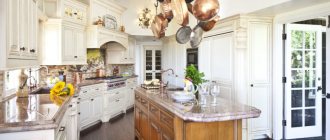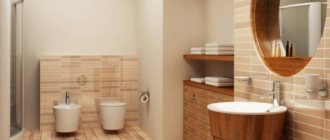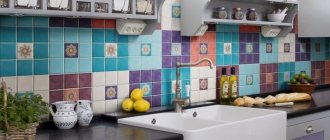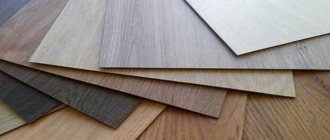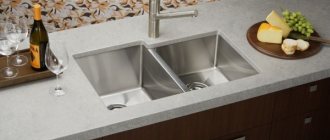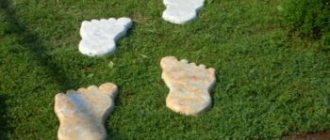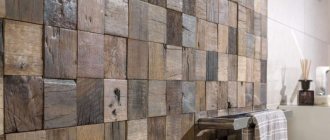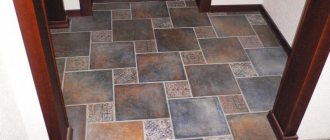There were times when stone blocks were turned into tiles solely due to the efforts of stonemasons, who manually carried out sawing, grinding and polishing. Since then, a lot of water has flown under the bridge: all these operations are carried out by machines, and the production of a wide range of stone finishing materials has been put into production. It is mainly used for cladding facades; gypsum imitation is more often used indoors. But natural stone tiles in the interior are also not uncommon - it’s all just a matter of price.
Modern trend for luxury interiors – onyx with backlight
Wood floor tiles
Wood-look floor
tiles with wood texture are perfect for floors, walls, and ceilings. Different types of wood look good in a variety of interiors. There are recommendations on which species to choose depending on the design of the room: white pine for Provence style, black oak for Japanese, etc.
And using natural wood for decoration is too expensive, besides, wood is a capricious material and difficult to care for. At the same time, technologies for manufacturing and processing wood-look ceramic floor tiles are now so developed that it can be difficult to distinguish the product from natural wood at first glance. The assortment of “wood” designs is huge, you can choose any color and texture.
Currently, the Russian market offers a large number of porcelain stoneware floor tiles from Russian, Ukrainian, Spanish and other manufacturers. Compared to Western European ones, domestic and Ukrainian ones are on average two times cheaper with good quality and beautiful execution.
Advice. When choosing wood flooring, you need to take into account the size and specifics of the room. For small rooms, light wood tones (pine, birch, etc.) with a softly expressed texture are recommended (catchy lines, as well as dark and bright colors, visually narrow the space). For halls and large living rooms, more saturated colors are suitable: stained oak, cherry. Combinations of different “breeds” look good, as well as combinations with wall tiles imitating cork, leather, fabric, bamboo.
Types of stone tiles made from natural materials
Marble
Marble is a rock made from calcium carbonate with admixtures of various organic compounds. Calcium grains are tightly woven at the molecular level, and the stone is easy to cut and polish.
Due to various inclusions, the pattern turns out to be heterogeneous, but characteristic - veins or streaks that differ in color from the background. The color palette of marble includes all shades:
- white,
- gray,
- black,
- green,
- red,
- orange.
Of course, these tones are not found in their pure form - they are mostly saturated (deep green, burgundy) or muted (sand, terracotta).
The surface is porous, so after installation it needs a protective impregnation that will protect the floor or wall from dirt, water absorption, exposure to coloring substances, etc.
Granite tiles
Granite is another stone with a grainy texture. The rock contains feldspars, quartz inclusions, mica and some other mineral components.
This is one of the most durable, dense and hard facing materials, so granite tiles, even without protective varnish, will last a long time, withstand all kinds of loads, and are incredibly difficult to damage.
The color palette includes products in gray, black, pink, reddish, brown and red-brown tones. Suitable for installation in both residential and commercial premises with extremely high loads.
Onyx tiles
Onyx is a beautiful mineral, essentially a type of quartz with a characteristic “striped” texture. As a rule, it is associated with an ornamental stone, from which women's jewelry, decorative tables, figurines, chess and much more are made.
But for the production of finishing materials for walls and floors, a cheaper type of onyx is used - calcite. The cladding is difficult to process, but the texture is exquisite, as if translucent.
This is especially noticeable when using backlighting. Often, tiles made from this mountain mineral are used in interiors, where it is important to emphasize the luxury and aristocracy of the environment. Although the material is expensive, it does not require surface protection.
Travertine tiles
Travertine is a rock known to geologists as calcareous tuff. It is formed from calcium minerals and has a polycrystalline, porous structure. Since it can be easily sanded and polished, it is often used as indoor cladding.
Ready-to-lay tiles have white, gray or yellowish-brown shades. The density and surface hardness of the material are low, so it is not recommended for installation on the floor in high-traffic areas.
To protect travertine floor and wall coverings from moisture, abrasion, dust and dirt, it is advisable to treat the surface with stone varnish.
If the interior of an office, restaurant, hotel or any other commercial premises requires travertine floor tiles, then it is better to replace them with PEI IV class porcelain tiles with tuff-like decor.
Slate tiles
Slate is a rock with a layered structure. Thanks to this, the texture of the stone is unusual and expressive even in matte black. The background color is usually:
- grayish,
- beige-sand or ocher,
- muted burgundy or green.
The surface of slate tiles is quite hard and dense, so the finishing coating does not absorb water, and dirt and dust do not eat into the pores. It is often used for facade cladding and finishing of adjacent areas.
Indoors it can be successfully installed in bathrooms, kitchens and other rooms with normal and high humidity levels.
Sandstone tiles
Sandstone is one of the most common sedimentary rocks containing quartz, feldspars and other mineral formations. The most famous variety is shell rock, which is often used for exterior wall decoration.
The structure of the stone can be uniform or layered, which is why the surface patterns are replete with a variety of options. The color range is wide - from gray-white to dark brown. Designers love to use this cladding material for antique, country, chalet, etc. interiors.
Sandstone tiles are quite durable, so they are used for finishing interior spaces and facades. But it is not recommended to leave the material without a protective coating - over time, a coating forms on the sandstone, which can only be removed by completely grinding the surface.
Volcanic tuff
Igneous rock composed of a variety of minerals. Thanks to a unique heat treatment, one of the types used for the production of cladding is characterized by high density and strength, so volcanic stone tiles can be used for finishing:
- facades,
- internal walls,
- floor.
Thanks to its special mosaic or striped texture, it goes well with other finishing materials. In addition, tuff is an excellent thermal insulation material. Very well suited for interior design in Mediterranean, Provençal and ethno styles.
Jadeite tiles
Jadeite is a mineral of the alkali pyroxene group. As a rule, it has gray-green shades, reminiscent of jade. Indeed, it is valued as an ornamental and even jewelry stone. But another type is also mined - large block.
Its quality is noticeably lower, but in its positive properties it is not inferior to marble. Jadeite is characterized by high density and heat capacity; it does not deform or crack under sudden changes in temperature and humidity.
This property of the material is so valuable that it is used mainly for baths and saunas. Polished jadeite tiles are used for cladding floors and walls in wet rooms, as well as facades.
Stone effect floor tiles
Stone -look flooring Decorative porcelain stoneware is also popular here, as well as ceramic and tile flooring. Possible stylizations of natural stone of various colors and textures, “aged” stone, with engraving, with a pattern. There are polished, glossy and matte varieties. For bathrooms, to avoid slipping and injury, matte, embossed, and rough are preferred.
As in the case of wood, natural stone is too expensive a finishing material. Stone-look floor tiles are in no way inferior to them in terms of aesthetics and reliability; moreover, they are much more resistant to wear and various types of impacts. And it is much easier to care for her.
Types of stone imitation
Stone walls can be created using various finishing materials. Currently, a huge variety of them are produced. Below are the most common ones.
Finishing artificial stone is made from a mixture of cement and sand with the addition of various additives (pigments, fillers) that improve performance and decorative functions.
Tiles imitating stone have long gained well-deserved popularity. It is durable, abrasion resistant and has a wonderful appearance.
Recently, stone panels have become extremely popular. They can be used for finishing both facades and interior spaces.
Such stone imitation as porcelain stoneware has been known for many years. It is much more durable and stronger than ceramic tiles. There are many different colors and textures of this finishing material. Today, innovative decorative 3D panels with amazing reliefs are also produced.
Marble floor tiles
Marble-like flooring
One of the varieties of “stone-like” tiles is “marble-like” tiles. Everything that relates to stone stylizations also applies here.
M frame comes in various types, colors and shades. Marble-like floor tiles reproduce them all: black marble, white, other colors, “aged” marble, “with cracks”, etc. Thanks to modern technologies, each set has a unique marble pattern that is not repeated even in the same collection.
The advantages of tiling over natural marble: it is more moisture resistant, stronger and easier to clean. It is more difficult to clean marble, despite the fact that it is a fairly easily soiled material.
Types of stone panels
Most often, this finishing material is produced by high pressure casting. Depending on its composition, panels are distinguished:
- Having a homogeneous structure (made of high-quality PVC).
- Combined (the outer layer is made of polymer, and the inner layer is made of polystyrene foam). This material is a good insulator, so it is in high demand.
- Manufactured using expanded polystyrene and polystyrene foam, combined with an outer covering.
Many panels contain resins, foam and stone powder. There are a huge number of models of facade panels on sale that imitate types of stone such as slate, limestone, sandstone, malachite, quartzite, topaz. Varieties with relief shapes (ruble or rocky stone) are also popular. On sale you can also find materials resembling flat basalt, onyx, granite, travertine, goldite, and dolomite. The most popular models are those with neatly laid rows of rectangular stones.
Thanks to the variety of these panels, anyone can quickly decorate their home as an Alpine house or as a medieval wall for relatively little money. Due to the wide color palette for facade panels, you can choose any shade of stone from light beige and white to dark brown and black. Such a variety of colors allows you to create a harmonious combination of the house and the surrounding landscape.
Floor tiles for laminate
Flooring under laminate
There is no limit to perfection. There are technologies that make it possible to make laminate flooring “like tiles,” and there are others that make it possible to make floor tiles like laminate flooring. Despite the fact that these are completely different materials, both have a lot of advantages. In particular, an elegant look and a variety of design solutions.
Where are floor tiles under laminate or parquet most often used? Of course, in the bathroom, where technical conditions do not allow laying either one or the other. And also in the kitchen: firstly, there is also high humidity, and secondly, fat, soot and other costs of kitchen processes. The tiles are easy to clean and are not afraid of moisture and caustic substances. Unlike laminate, it never forms a stain that cannot be removed later.
Properties of stone-look facade panels
This finishing material is not afraid of high or low temperatures, moisture and salts. Since it has a low coefficient of linear expansion, these panels do not deform for many years. A reliable joint system allows them to withstand even strong winds. High-quality materials are resistant to fading in the sun. Other properties of stone-look facade panels include:
- wear resistance;
- low thermal conductivity;
- good sound insulation;
- impact resistance;
- corrosion resistance;
- fire resistance.
This finishing material has the following advantages: low cost, light weight, and the ability to install on any type of wall without special preparation.

